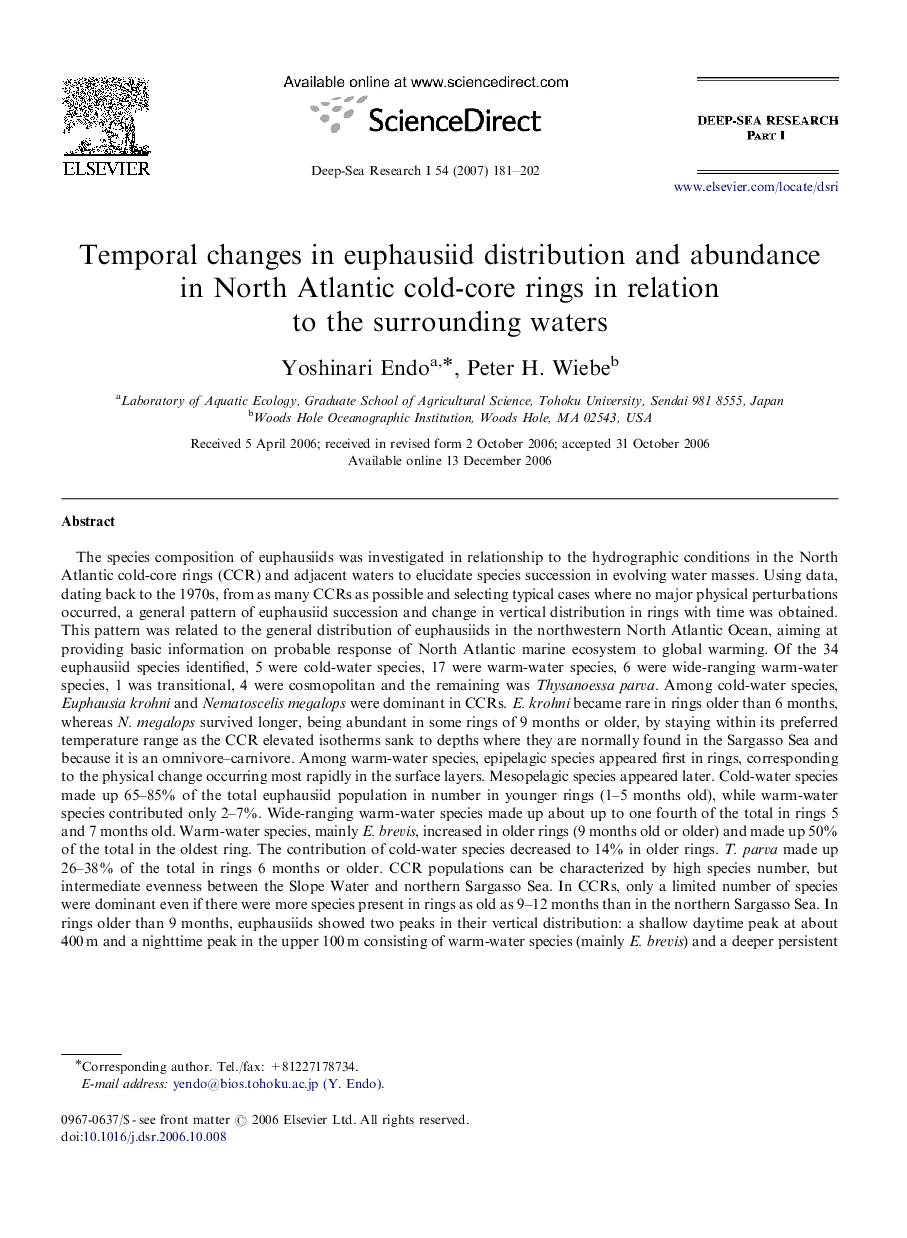| کد مقاله | کد نشریه | سال انتشار | مقاله انگلیسی | نسخه تمام متن |
|---|---|---|---|---|
| 4535601 | 1326121 | 2007 | 22 صفحه PDF | دانلود رایگان |
عنوان انگلیسی مقاله ISI
Temporal changes in euphausiid distribution and abundance in North Atlantic cold-core rings in relation to the surrounding waters
دانلود مقاله + سفارش ترجمه
دانلود مقاله ISI انگلیسی
رایگان برای ایرانیان
کلمات کلیدی
موضوعات مرتبط
مهندسی و علوم پایه
علوم زمین و سیارات
زمین شناسی
پیش نمایش صفحه اول مقاله

چکیده انگلیسی
The species composition of euphausiids was investigated in relationship to the hydrographic conditions in the North Atlantic cold-core rings (CCR) and adjacent waters to elucidate species succession in evolving water masses. Using data, dating back to the 1970s, from as many CCRs as possible and selecting typical cases where no major physical perturbations occurred, a general pattern of euphausiid succession and change in vertical distribution in rings with time was obtained. This pattern was related to the general distribution of euphausiids in the northwestern North Atlantic Ocean, aiming at providing basic information on probable response of North Atlantic marine ecosystem to global warming. Of the 34 euphausiid species identified, 5 were cold-water species, 17 were warm-water species, 6 were wide-ranging warm-water species, 1 was transitional, 4 were cosmopolitan and the remaining was Thysanoessa parva. Among cold-water species, Euphausia krohni and Nematoscelis megalops were dominant in CCRs. E. krohni became rare in rings older than 6 months, whereas N. megalops survived longer, being abundant in some rings of 9 months or older, by staying within its preferred temperature range as the CCR elevated isotherms sank to depths where they are normally found in the Sargasso Sea and because it is an omnivore-carnivore. Among warm-water species, epipelagic species appeared first in rings, corresponding to the physical change occurring most rapidly in the surface layers. Mesopelagic species appeared later. Cold-water species made up 65-85% of the total euphausiid population in number in younger rings (1-5 months old), while warm-water species contributed only 2-7%. Wide-ranging warm-water species made up about up to one fourth of the total in rings 5 and 7 months old. Warm-water species, mainly E. brevis, increased in older rings (9 months old or older) and made up 50% of the total in the oldest ring. The contribution of cold-water species decreased to 14% in older rings. T. parva made up 26-38% of the total in rings 6 months or older. CCR populations can be characterized by high species number, but intermediate evenness between the Slope Water and northern Sargasso Sea. In CCRs, only a limited number of species were dominant even if there were more species present in rings as old as 9-12 months than in the northern Sargasso Sea. In rings older than 9 months, euphausiids showed two peaks in their vertical distribution: a shallow daytime peak at about 400Â m and a nighttime peak in the upper 100Â m consisting of warm-water species (mainly E. brevis) and a deeper persistent peak at 800Â m or deeper consisting of the species N. megalops and T. parva. This shallow peak in CCRs is shallower than that in the surrounding northern Sargasso Sea, and the deep peak is rarely observed in these waters.
ناشر
Database: Elsevier - ScienceDirect (ساینس دایرکت)
Journal: Deep Sea Research Part I: Oceanographic Research Papers - Volume 54, Issue 2, February 2007, Pages 181-202
Journal: Deep Sea Research Part I: Oceanographic Research Papers - Volume 54, Issue 2, February 2007, Pages 181-202
نویسندگان
Yoshinari Endo, Peter H. Wiebe,